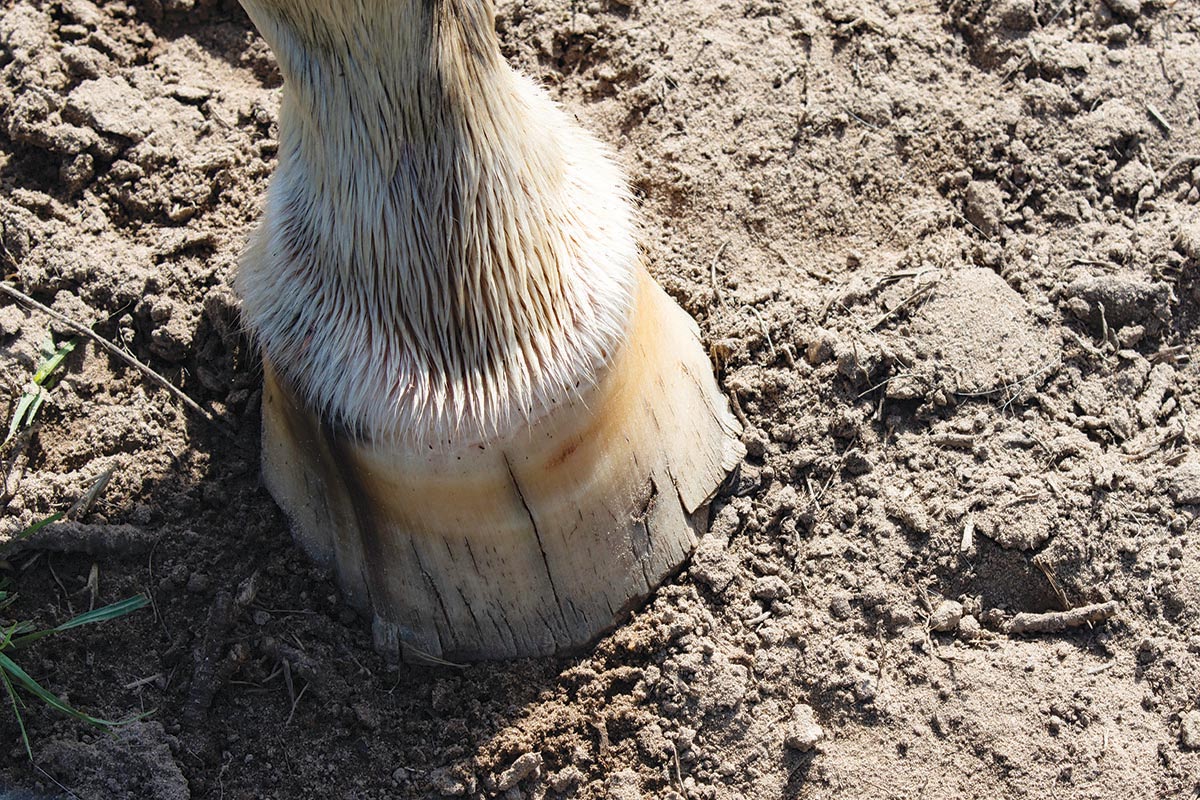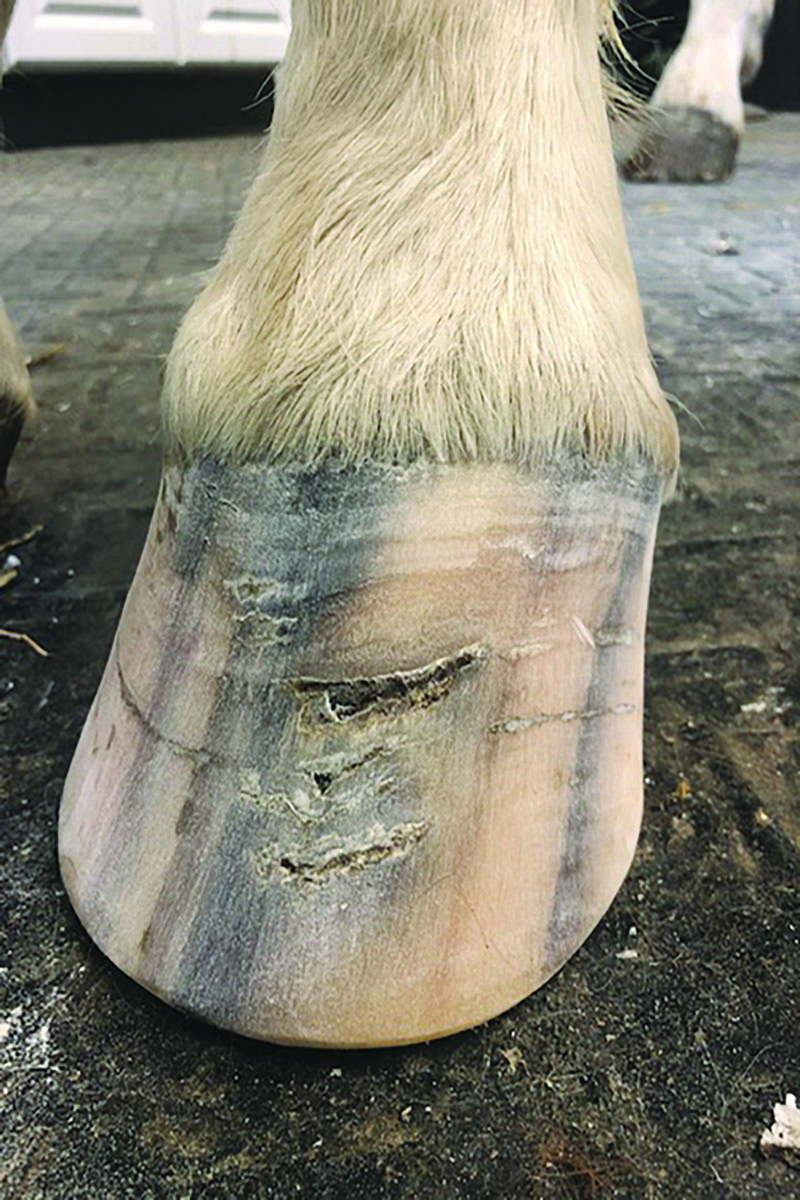Feet are the foundation of the horse; everything starts from the bottom up.

Both barefoot and shod horses can develop hoof cracks. Small hoof cracks and chipping around the bottom edges is not unusual in a barefoot hoof as it grows, and the farrier can generally trim these cracks away.
Shod horses can develop hoof cracks around the nails if they aren’t placed properly. When a shod horse ends up with a deep crack in the hoof, this may be more related to load-bearing issues than hoof growth. Hoof cracks shouldn’t be ignored, because problems can develop when the hoof’s integrity is compromised.
“Horse hoof cracks can open the barrier of the hoof capsule and allow bacteria in,” notes Bras. “You can end up with a secondary problem if opportunistic bacteria enter, and then you have an infection.”

Seeking the Cause for Horse Hoof Cracks
The reason behind a hoof crack isn’t always straightforward.
“Horse hoof cracks can be secondary to something else,” says Bras, who often sees cracks related to limb conformation. “Realistically, there is not a perfect horse, but saying that hoof cracks are due to hereditary issues is a cop out, because there are other factors besides conformation and genetics.”
Horse hoof cracks reflect the quality of the hoof, which is influenced by a number of factors, including:
◆ Hoof care schedule
◆ Footing and environment
◆ Weather
◆ Nutrition
“Superficial horse hoof cracks are usually related to weather and environment,” says Bras.
The horse’s feet tend to mirror his environment. When it’s overly wet, the hoof can absorb too much moisture, which makes it soft and more vulnerable to bruising, abscesses and bacterial infection. A hoof that is overly dry becomes hard and brittle, so it loses flexibility, which can allow the wall to chip or break around the edges, or if the horse is shod, for nails to loosen.

Failure to maintain a regular hoof care schedule is often the cause of cracks as hooves get too long. All horses need regular hoof care year-round, even if they aren’t being used or are barefoot.
When the horse hoof is allowed to grow excessively, it will flare out around the bottom, and the natural shape will be distorted, allowing it to crack more easily.
“If you give the horse a break without hoof care for months, you get into flares, distortion, cracks and hoof wall separations,” says Bras. “A crack that starts at the bottom of the foot and works its way up is usually related to flares or distortions.”
Don’t Overlook Nutrition
Bras points out that applying topical products to the hoof can change it to some extent, but hooves grow from the inside out, so nutrition should always be considered if a horse has poor hooves.

Horse hooves and hair require many of the same nutrients, so a horse with a dull, dry hair coat will likely have poor-quality hooves.
“If a horse is on a well-balanced diet, he should get all the requirements needed for the blood supply to provide nutrients to grow a healthy hoof capsule,” says Bras. “Horses do metabolize nutrients differently, however. Some horses, even with a good diet, have poor-quality feet. In these cases, you might need a hair sample analysis to find out if the horse has a specific nutrient deficiency that needs to be addressed.”
When Horse Hoof Cracks Cause Concern
You should contact your farrier and veterinarian any time significant change occurs in a hoof or if the horse shows signs of lameness. Certain types of horse hoof cracks are cause for concern and require prompt attention from your farrier, and in some cases, your veterinarian, as well. These include:
◆ A horizontal crack parallel to the hairline
◆ Any horse hoof crack that involves bleeding
◆ A hoof crack that involves separation at the hairline
◆ If there is movement or separation in the hoof on one or both sides of a crack
◆ A vertical horse hoof crack in the rear portion of the hoof extending down from the coronary band (see below)
◆ A horizontal crack in the hoof that runs parallel to the hairline is often related to an injury or abscess. This type of crack is typically an interruption of normal growth extending down from the coronary band.A deep horse hoof crack will bleed; superficial cracks won’t. Bleeding from a hoof crack indicates that internal structures of the hoof are involved. This kind of crack always requires veterinary attention, whether or not the horse is lame.
If you see separation at the hairline, Bras explains this indicates that the integrity of the hoof capsule is compromised.
“This can be a weak spot that may eventually become a horizontal crack that can allow opportunistic bacteria to enter,” he notes. “If the horse hoof crack continues to grow, it will get to the load-bearing surface of the hoof, and the hoof can break.”

If you can see movement in the hoof on one or both sides of a crack, this is serious, as it means the hoof capsule has sustained significant compromise.
When a barefoot horse develops a hoof crack in the middle of the toe at the front of the hoof, this can open the door for opportunistic bacteria and potentially lead to infection, such as white line disease. In addition to trimming the area specifically to address the toe crack, your farrier will likely recommend a topical product to kill bacteria.
Quarter Cracks in Horse Hooves
Located in the back quadrant of the horse hoof, a quarter horse hoof crack is a vertical crack that originates at the coronary band and extends downward. This type of crack starts internally and only becomes visible when it “pops.” The horse may or may not be lame.
“Quarter cracks don’t always bleed, and every bleeding quarter crack doesn’t always create lameness,” says Bras. “If you do have a bleeding quarter crack, you should always be concerned, because internal structures are involved, even if the horse is not lame.” He notes that quarter cracks are usually related to load-bearing and how the horse moves.

This is a serious type of horse hoof crack that cannot be ignored, as it reduces the load-bearing surface of the hoof. Your farrier and veterinarian should be involved in treatment, which may require wire lacing and/or a patch or glue to stabilize the crack. A therapeutic shoe, such as a bar shoe, may also be needed to take pressure off the section of hoof below the crack.
Hoof Care Schedule
Your first line of defense against horse hoof cracks is regular attention by a hoof-care professional. Because your farrier typically comes every four to six weeks, he or she should note any significant changes in the feet and should mention if your veterinarian should also be consulted.
“The farrier looks at things from the outside in, while the veterinarian is looking at it from the inside out, thinking of interior structure problems in the hoof that may reveal outer signs, like cracks,” says Bras. “A farrier and a veterinarian provide very different services, but with you as the horse’s owner, it’s a team of three.”

Many owners ask how often their horses’ hooves require trimming or shoeing, but there is no black-and-white answer to this question.
“If the horse grows a lot of foot, he likely needs care every four weeks; with a horse that doesn’t grow much foot, every four weeks is probably too often,” says Bras.
Every horse is an individual and the hoof care schedule must be adjusted to fit each horse. The time between trimming or shoeing should be short enough that your horse’s hooves haven’t started to distort in shape by flaring, chipping or cracking before the next farrier visit.
Consult with your farrier to determine the best schedule, stick with it, and keep a close eye on your horse’s hooves in between visits. And if you need help for a hoof crack or other issue, then don’t hesitate to get advice or have the farrier out for an extra visit.
This article about caring for horse hoof cracks appeared in the June 2021 issue of Horse Illustrated magazine. Click here to subscribe!




